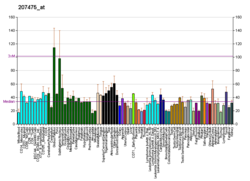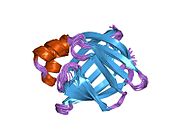
FABP2
| FABP2 | |||||||||||||||||||||||||||||||||||||||||||||||||||
|---|---|---|---|---|---|---|---|---|---|---|---|---|---|---|---|---|---|---|---|---|---|---|---|---|---|---|---|---|---|---|---|---|---|---|---|---|---|---|---|---|---|---|---|---|---|---|---|---|---|---|---|
 | |||||||||||||||||||||||||||||||||||||||||||||||||||
| |||||||||||||||||||||||||||||||||||||||||||||||||||
| Identifiers | |||||||||||||||||||||||||||||||||||||||||||||||||||
| Aliases | FABP2, FABPI, I-FABP, fatty acid binding protein 2 | ||||||||||||||||||||||||||||||||||||||||||||||||||
| External IDs | OMIM: 134640 MGI: 95478 HomoloGene: 107 GeneCards: FABP2 | ||||||||||||||||||||||||||||||||||||||||||||||||||
| |||||||||||||||||||||||||||||||||||||||||||||||||||
| |||||||||||||||||||||||||||||||||||||||||||||||||||
| |||||||||||||||||||||||||||||||||||||||||||||||||||
| |||||||||||||||||||||||||||||||||||||||||||||||||||
| |||||||||||||||||||||||||||||||||||||||||||||||||||
| Wikidata | |||||||||||||||||||||||||||||||||||||||||||||||||||
| |||||||||||||||||||||||||||||||||||||||||||||||||||
Fatty acid-binding protein 2 (FABP2) also known as Intestinal-type fatty acid-binding protein (I-FABP) is a protein that in humans is encoded by the FABP2 gene.
Function
The intracellular fatty acid-binding proteins (FABPs) belong to a multigene family with nearly twenty identified members. FABPs are divided into at least three distinct types, namely the hepatic-, intestinal- and cardiac-type. They form 14-15 kDa proteins and are thought to participate in the uptake, intracellular metabolism and/or transport of long-chain fatty acids. They may also be responsible in the modulation of cell growth and proliferation. Intestinal fatty acid-binding protein 2 gene contains four exons and is an abundant cytosolic protein in small intestine epithelial cells.
Clinical significance
This gene has a polymorphism at codon 54 that identified an alanine-encoding allele and a threonine-encoding allele. Thr-54 protein is associated with increased fat oxidation and insulin resistance.
Further reading
- Kaikaus RM, Bass NM, Ockner RK (1990). "Functions of fatty acid binding proteins". Experientia. 46 (6): 617–30. doi:10.1007/BF01939701. PMID 2193826. S2CID 21746837.
- Glatz JF, Luiken JJ, van Nieuwenhoven FA, Van der Vusse GJ (1997). "Molecular mechanism of cellular uptake and intracellular translocation of fatty acids". Prostaglandins Leukot. Essent. Fatty Acids. 57 (1): 3–9. doi:10.1016/S0952-3278(97)90485-3. PMID 9250601.
- Storch J, Thumser AE (2000). "The fatty acid transport function of fatty acid-binding proteins" (PDF). Biochim. Biophys. Acta. 1486 (1): 28–44. doi:10.1016/s1388-1981(00)00046-9. PMID 10856711.
- Edwards A, Hammond HA, Jin L, et al. (1992). "Genetic variation at five trimeric and tetrameric tandem repeat loci in four human population groups". Genomics. 12 (2): 241–53. doi:10.1016/0888-7543(92)90371-X. PMID 1740333.
- Polymeropoulos MH, Rath DS, Xiao H, Merril CR (1991). "Trinucleotide repeat polymorphism at the human intestinal fatty acid binding protein gene (FABP2)". Nucleic Acids Res. 18 (23): 7198. doi:10.1093/nar/18.23.7198-a. PMC 332847. PMID 2263509.
- Sweetser DA, Birkenmeier EH, Klisak IJ, et al. (1987). "The human and rodent intestinal fatty acid binding protein genes. A comparative analysis of their structure, expression, and linkage relationships". J. Biol. Chem. 262 (33): 16060–71. doi:10.1016/S0021-9258(18)47696-X. PMID 2824476.
- Lowe JB, Boguski MS, Sweetser DA, et al. (1985). "Human liver fatty acid binding protein. Isolation of a full length cDNA and comparative sequence analyses of orthologous and paralogous proteins". J. Biol. Chem. 260 (6): 3413–7. doi:10.1016/S0021-9258(19)83637-2. PMID 3838313.
- Baier LJ, Sacchettini JC, Knowler WC, et al. (1995). "An amino acid substitution in the human intestinal fatty acid binding protein is associated with increased fatty acid binding, increased fat oxidation, and insulin resistance". J. Clin. Invest. 95 (3): 1281–7. doi:10.1172/JCI117778. PMC 441467. PMID 7883976.
- Goold RD, diSibio GL, Xu H, et al. (1993). "The development of sequence-tagged sites for human chromosome 4". Hum. Mol. Genet. 2 (8): 1271–88. doi:10.1093/hmg/2.8.1271. PMID 8401509.
- Prochazka M, Lillioja S, Tait JF, et al. (1993). "Linkage of chromosomal markers on 4q with a putative gene determining maximal insulin action in Pima Indians". Diabetes. 42 (4): 514–9. doi:10.2337/diabetes.42.4.514. PMID 8454101.
- Hegele RA, Harris SB, Hanley AJ, et al. (1997). "Genetic variation of intestinal fatty acid-binding protein associated with variation in body mass in aboriginal Canadians". J. Clin. Endocrinol. Metab. 81 (12): 4334–7. doi:10.1210/jcem.81.12.8954037. PMID 8954037. S2CID 33956687.
- Zhang F, Lücke C, Baier LJ, et al. (1997). "Solution structure of human intestinal fatty acid binding protein: implications for ligand entry and exit". J. Biomol. NMR. 9 (3): 213–28. doi:10.1023/A:1018666522787. PMID 9204553. S2CID 24409209.
- Darimont C, Gradoux N, Cumin F, et al. (1998). "Differential regulation of intestinal and liver fatty acid-binding proteins in human intestinal cell line (Caco-2): role of collagen". Exp. Cell Res. 244 (2): 441–7. doi:10.1006/excr.1998.4186. PMID 9806794.
- Darimont C, Gradoux N, de Pover A (1999). "Epidermal growth factor regulates fatty acid uptake and metabolism in Caco-2 cells". Am. J. Physiol. 276 (3 Pt 1): G606–12. doi:10.1152/ajpgi.1999.276.3.G606. PMID 10070036.
- Carlsson M, Orho-Melander M, Hedenbro J, et al. (2000). "The T 54 allele of the intestinal fatty acid-binding protein 2 is associated with a parental history of stroke". J. Clin. Endocrinol. Metab. 85 (8): 2801–4. doi:10.1210/jcem.85.8.6751. PMID 10946885.
- Chiu KC, Chuang LM, Yoon C (2003). "The A54T polymorphism at the intestinal fatty acid binding protein 2 is associated with insulin resistance in glucose tolerant Caucasians". BMC Genet. 2: 7. doi:10.1186/1471-2156-2-7. PMC 31346. PMID 11299043.
- Makowski L, Boord JB, Maeda K, et al. (2001). "Lack of macrophage fatty-acid-binding protein aP2 protects mice deficient in apolipoprotein E against atherosclerosis". Nat. Med. 7 (6): 699–705. doi:10.1038/89076. PMC 4027052. PMID 11385507.
|
PDB gallery
| |
|---|---|
| Fatty acid | |
|---|---|
| Hormone | |
| Metal/element | |
| Vitamin | |
| Pigment | |
| Other | |







